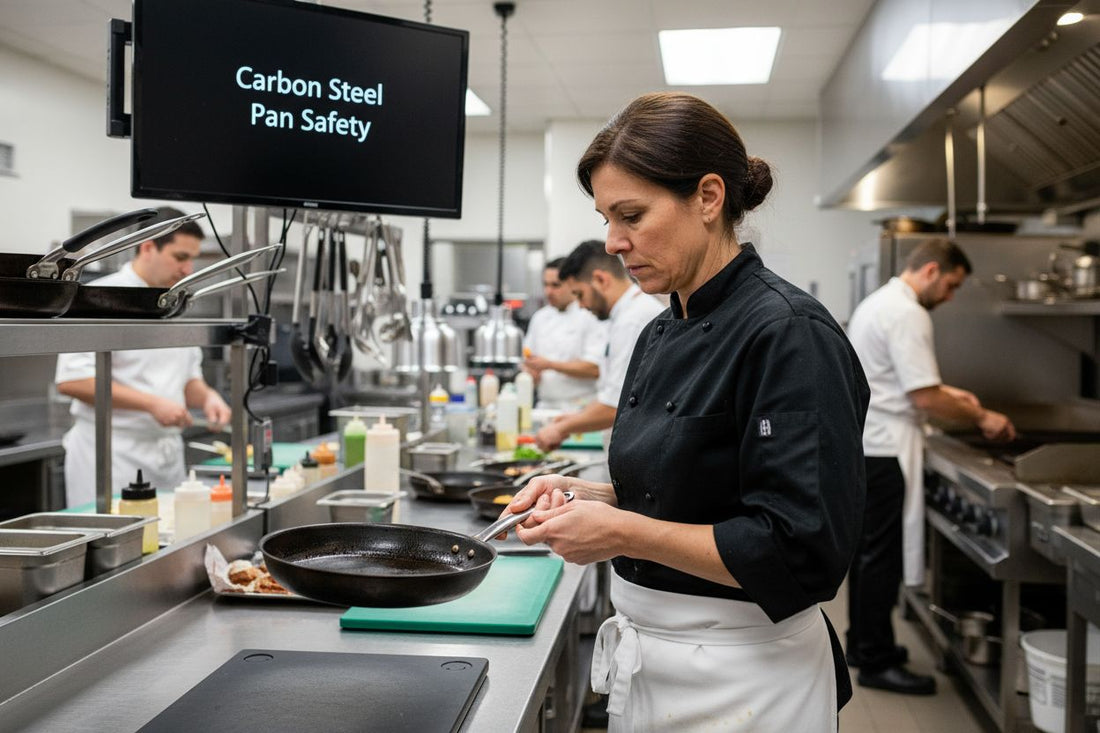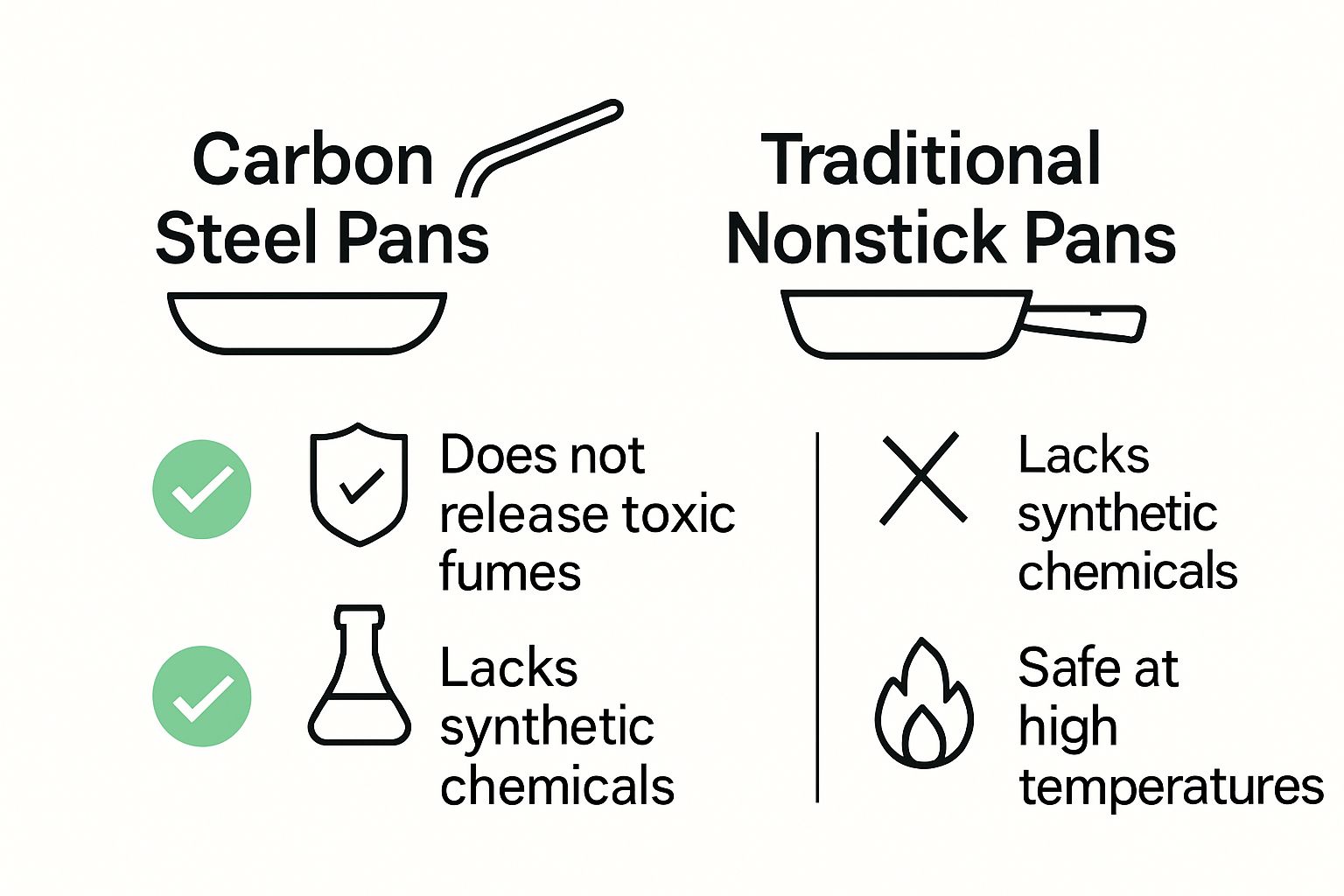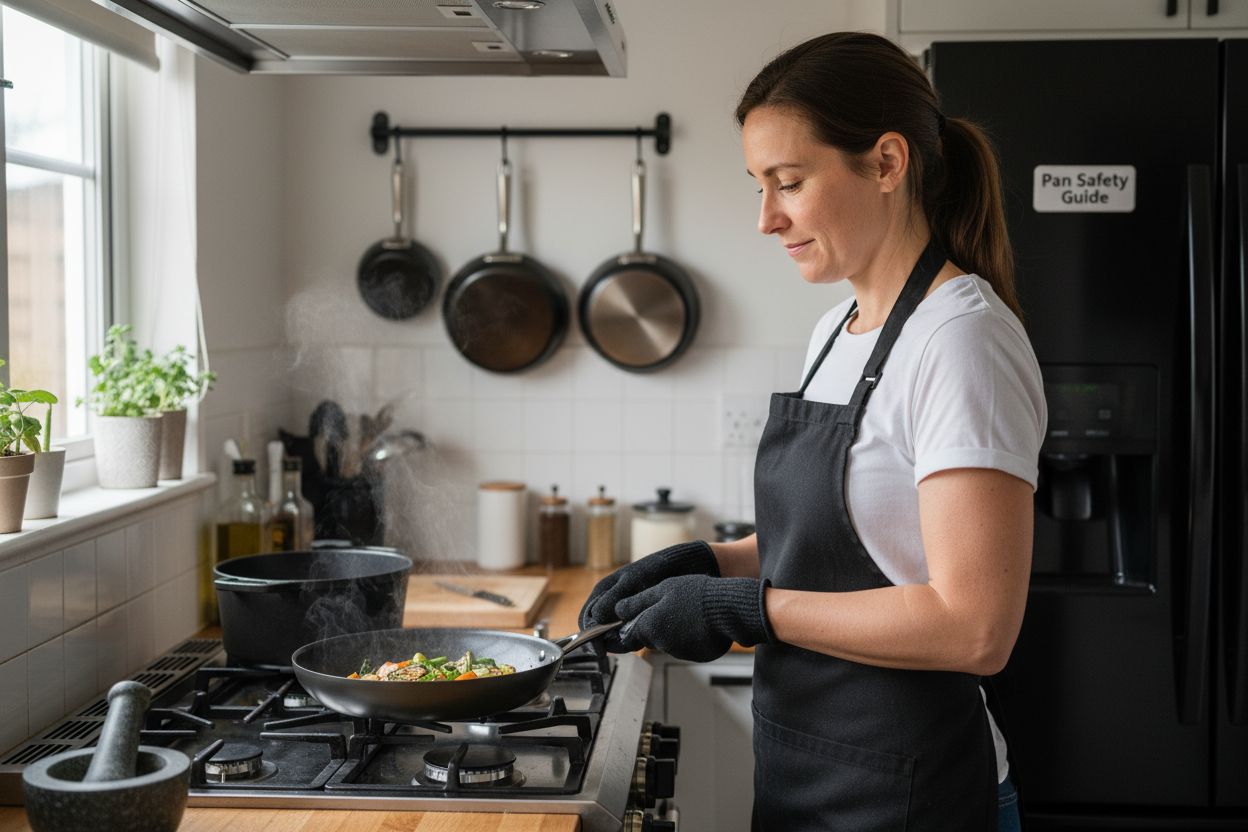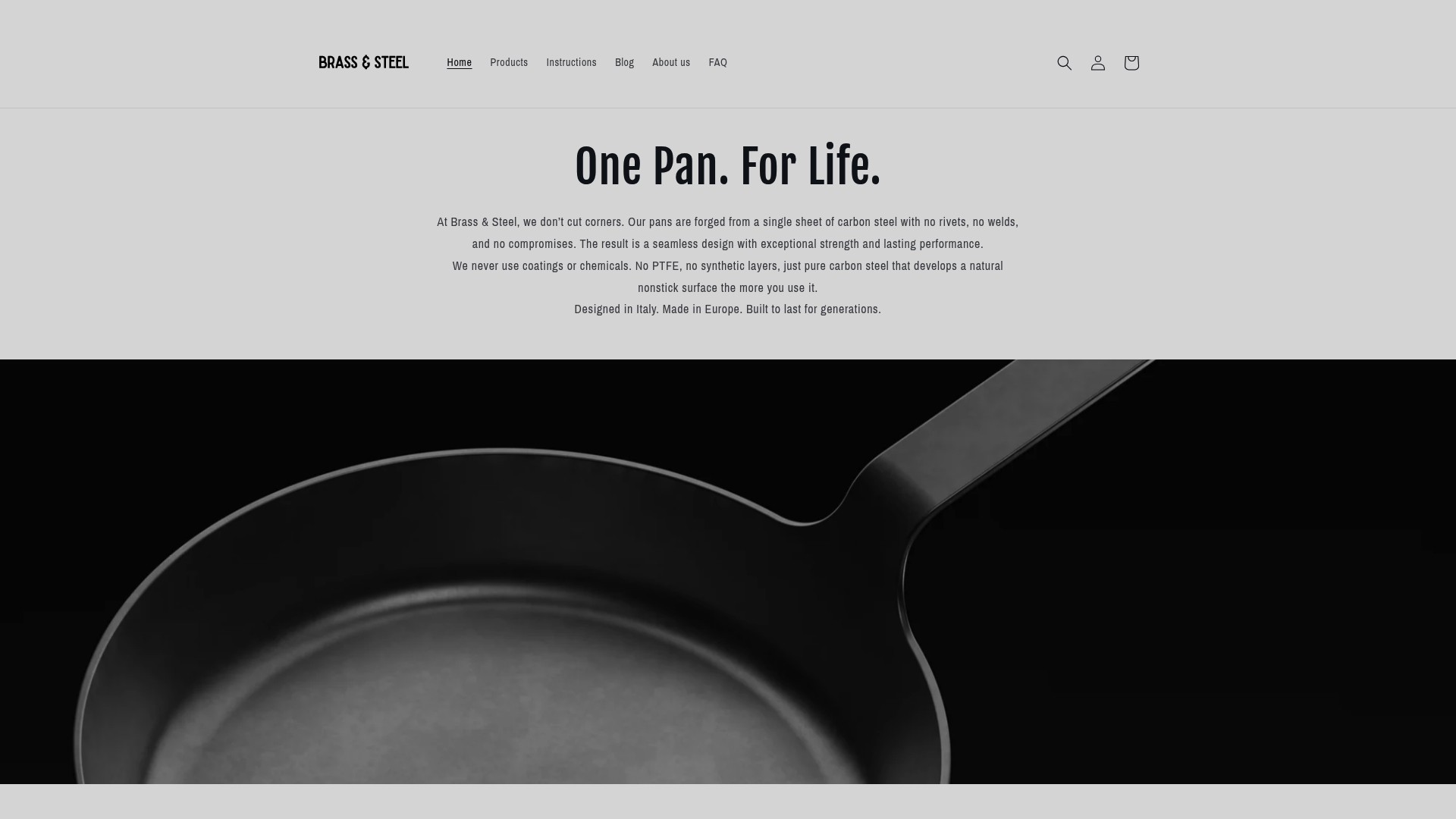
Understanding Carbon Steel Pan Safety Guide for Chefs
Share
Carbon steel pans have earned their place in top kitchens for very good reasons. These tough, versatile pans can withstand intense heat and develop a natural nonstick surface as they age. But it might surprise you that carbon steel contains no synthetic chemicals like PFOA or PTFE, which are found in many other nonstick pans. This simple fact means cooks get both professional-level performance and peace of mind, without any of the usual safety worries lurking in the background.
Table of Contents
- What Is A Carbon Steel Pan And Its Properties?
- Why Safety Matters When Using Carbon Steel Pans
- How To Care For And Maintain Carbon Steel For Safety
- Identifying Risks And Preventing Accidents With Carbon Steel
- The Role Of Food Safety In Cooking With Carbon Steel Pans
Quick Summary
| Takeaway | Explanation |
|---|---|
| Carbon steel pans evolve with use | The nonstick surface improves over time through a natural seasoning process, enhancing performance with each use. |
| Avoid moisture to prevent rust | Proper storage and avoidance of moisture are crucial to maintain the integrity and performance of carbon steel pans. |
| No harmful chemicals involved | Carbon steel is free from synthetic coatings, making it a safer alternative compared to traditional nonstick cookware. |
| Use appropriate utensils for safety | To prevent scratching and damage to the pan’s surface, it is essential to use suitable cooking utensils during use. |
| Monitor heat levels for safety | Understanding heat distribution and sensitivity is vital for avoiding burns or accidents when cooking with carbon steel. |
What is a Carbon Steel Pan and Its Properties?
Carbon steel pans represent a time honoured cooking tool beloved by professional chefs and serious home cooks worldwide. These versatile cookware pieces are crafted from an alloy primarily composed of iron and carbon, typically containing between 0.5% to 2% carbon content. Learn more about carbon steel pan fundamentals.
Material Composition and Manufacturing
Carbon steel pans are distinguished by their exceptional durability and heat conductivity. Unlike stainless steel or aluminium cookware, carbon steel offers a unique combination of strength and thermal performance. Manufacturers forge these pans through a precise process that involves:
- Heating iron and carbon alloy to extremely high temperatures
- Pressing and shaping the metal into a seamless pan structure
- Carefully controlling carbon content for optimal performance
The result is a robust cooking surface that develops a natural nonstick patina over time, making it increasingly effective with each use. Professional chefs prize carbon steel for its ability to withstand intense heat and provide superior heat distribution.
Performance and Culinary Characteristics
What sets carbon steel apart is its remarkable ability to respond quickly to temperature changes. When heated, these pans develop an incredibly smooth surface that becomes progressively more nonstick through a process called seasoning. This natural seasoning occurs as cooking oils polymerise and create a protective layer, transforming the pan’s surface.
Carbon steel pans excel in high-heat cooking techniques such as searing, sautéing, and creating restaurant-quality finishes on meats and vegetables. Their lightweight design compared to cast iron and superior heat retention make them a preferred choice for professional kitchens seeking precision and performance.
By understanding the intricate properties of carbon steel, cooks can unlock a cooking tool that improves with age and delivers consistently exceptional culinary results.
This comparison table highlights how carbon steel pans differ from other common cookware in terms of construction, safety attributes, and performance, supporting informed decision-making for chefs and home cooks.
| Cookware Material | Core Materials | Nonstick Surface | Chemical Coatings | Typical Uses |
|---|---|---|---|---|
| Carbon Steel | Iron, Carbon | Develops with seasoning | None | Searing, sautéing, high heat |
| Stainless Steel | Iron, Chromium, Nickel | No natural nonstick | None | Versatile, boiling, frying |
| Aluminium (Nonstick) | Aluminium | PTFE/PFOA-based coating | Yes | Low-fat frying, general cooking |
| Cast Iron | Iron, Carbon | Develops with seasoning | None | Slow cooking, baking, frying |
| Ceramic-coated | Metal with ceramic layer | Manufactured coating | Sometimes | Low-oil cooking, delicate dishes |
Why Safety Matters When Using Carbon Steel Pans
Safety is paramount when selecting and using cookware, and carbon steel pans offer remarkable advantages in this domain. Learn more about the health benefits of carbon steel pans. Unlike traditional nonstick cookware containing synthetic chemical coatings, carbon steel provides a natural cooking surface that evolves with proper care and usage.
Chemical Composition and Health Considerations
Carbon steel pans distinguish themselves through their minimalist composition. Constructed primarily from iron and carbon, these pans do not contain potentially harmful synthetic chemicals such as PFOA or PTFE, which are commonly found in traditional nonstick cookware. This inherent chemical simplicity makes carbon steel a healthier alternative for home and professional cooking environments.

Key health safety attributes include:
- Absence of synthetic chemical coatings
- Natural seasoning process creates protective layer
- No toxic fume release during high-temperature cooking
- Minimal potential for chemical leaching into food
Thermal Safety and Performance
Professional chefs and home cooks must understand thermal management when using carbon steel pans. These cookware pieces conduct heat exceptionally well but require specific handling techniques to prevent potential safety risks. Proper preheating, understanding heat distribution, and using appropriate cooking techniques are crucial for safe usage.
Temperature control involves several critical considerations:
- Gradual heating prevents warping and potential structural damage
- Avoiding sudden temperature changes reduces risk of pan failure
- Using appropriate utensils prevents surface scratching
- Regular maintenance ensures long term structural integrity
By comprehending these safety principles, cooks can transform carbon steel pans into reliable, long lasting culinary tools that support both exceptional cooking performance and personal kitchen safety.
How to Care for and Maintain Carbon Steel for Safety
Maintaining carbon steel pans is critical not just for their longevity but also for ensuring optimal cooking performance and kitchen safety. Discover comprehensive carbon steel maintenance techniques that protect both your cookware and culinary investments.
Cleaning and Preservation Techniques
Carbon steel requires nuanced cleaning approaches that differ significantly from other cookware materials. Avoiding water exposure and harsh chemical cleaners is fundamental to preserving the pan’s protective seasoning layer. Professional chefs understand that improper cleaning can compromise the pan’s natural nonstick surface and introduce potential safety risks.
Key cleaning considerations include:
- Using minimal water during cleaning
- Avoiding soap or harsh detergents
- Drying immediately after washing
- Applying a thin protective oil layer after each use
Preventing Corrosion and Degradation
Corrosion represents the primary threat to carbon steel pan safety and performance. Moisture and acidic environments can rapidly deteriorate the pan’s structural integrity. Implementing strategic storage and maintenance protocols prevents rust formation and maintains the pan’s cooking surface.
Critical corrosion prevention strategies involve:
- Storing in low humidity environments
- Using desiccant packets during storage
- Avoiding prolonged exposure to moisture
- Regularly inspecting for early rust signs
- Addressing minor rust patches immediately
By adopting these meticulous maintenance practices, cooks can transform carbon steel pans into generational cooking tools that remain safe, functional, and aesthetically pleasing throughout years of culinary exploration.
The table below summarises key safety considerations and maintenance requirements for carbon steel pans, making it easier to compare their roles in both performance and prevention of kitchen incidents.
| Safety Consideration | Role in Usage | Maintenance Requirement |
|---|---|---|
| Chemical Safety | Avoids harmful chemicals such as PFOA/PTFE | Maintain seasoning to create protective barrier |
| Thermal Safety | Withstands high heat, rapid heat conduction | Gradual heating avoids warping |
| Corrosion Prevention | Prevents rust and degradation | Store dry, apply oil, avoid moisture exposure |
| Mechanical Integrity | Avoids handle breaks or surface weakness | Inspect attachment points and pan deformities |
| Food Hygiene | Creates nonporous surface, limits bacteria | Dry thoroughly and regularly reseason |
Identifying Risks and Preventing Accidents with Carbon Steel
Carbon steel pans, while exceptional cooking tools, require careful handling to prevent potential kitchen accidents. Explore the comprehensive carbon steel health benefits guide to understand the nuanced safety considerations involved in their usage.
Thermal Handling and Heat Management
Thermal risks represent the most significant potential hazard when working with carbon steel cookware. These pans conduct heat rapidly and retain temperature extremely efficiently, which can lead to unexpected burns or kitchen accidents if proper precautions are not implemented. Professional chefs understand that thermal management extends beyond simply avoiding direct contact with hot surfaces.
Critical thermal safety considerations include:
- Using heat resistant cooking gloves
- Understanding pan temperature progression
- Avoiding sudden temperature transitions
- Implementing controlled heating techniques
- Maintaining consistent heat distribution
Structural Integrity and Mechanical Risks
Carbon steel pans can develop structural weaknesses if not maintained correctly, potentially creating unexpected safety challenges during cooking. Recognising early signs of pan degradation is crucial for preventing potential kitchen accidents. Mechanical risks emerge through factors such as surface damage, handle stability, and prolonged exposure to extreme conditions.
Key mechanical risk prevention strategies involve:
- Regular inspection of pan surface
- Checking handle attachment points
- Avoiding excessive force during cooking
- Monitoring for structural deformations
- Replacing pans showing significant wear
By comprehensively understanding these risk factors, cooks can transform carbon steel from a potentially hazardous cooking implement into a reliable, safe, and high performance culinary tool that supports exceptional cooking experiences.

The Role of Food Safety in Cooking with Carbon Steel Pans
Food safety is paramount when selecting and utilising cookware, and carbon steel pans offer unique characteristics that support hygienic cooking practices. Discover the nuances of cooking with carbon steel to ensure optimal culinary performance and health protection.
Microbial Prevention and Surface Characteristics
Carbon steel pans possess inherent properties that contribute to enhanced food safety standards. The pan’s natural seasoning process creates a smooth, nonporous surface that significantly reduces bacterial adhesion and proliferation. Professional chefs recognise that the molecular structure of well maintained carbon steel actively discourages microbial growth, unlike porous or scratched cooking surfaces.
Critical microbial prevention strategies include:
- Maintaining consistent pan seasoning
- Avoiding prolonged moisture retention
- Implementing high temperature cooking techniques
- Ensuring thorough surface drying after cleaning
- Regularly regenerating the pan’s protective layer
Chemical Interaction and Food Contamination Prevention
Understanding the chemical interactions between cookware and food is crucial for maintaining safety. Carbon steel demonstrates remarkable stability across diverse cooking environments, preventing potential chemical leaching or contamination that can occur with less robust materials. The pan’s natural iron composition actually contributes trace nutritional minerals to food without introducing harmful substances.
Key food safety considerations involve:
- Monitoring cooking temperature ranges
- Understanding metal reactivity with different ingredients
- Avoiding prolonged acidic food exposure
- Recognising signs of surface degradation
- Implementing proper seasoning maintenance
By comprehensively understanding these food safety principles, cooks can transform carbon steel pans into reliable culinary instruments that support both exceptional cooking performance and rigorous health protection standards.
Ready to Cook Safely and Confidently with Professional Carbon Steel?
You have explored the essential safety steps and performance secrets of carbon steel cookware. Now translate this knowledge into practice with expertly engineered tools built to handle every chef’s challenge. Discover the difference that single-piece construction, natural nonstick seasoning, and health-focused materials can make in your kitchen. For uncompromising durability and peace of mind, browse our Carbon Steel Collection | Brass&Steel – Brass & Steel, crafted specifically to empower chefs who demand reliability and precision.

Take your next step towards safer, healthier cooking. Visit Brass & Steel and experience cookware trusted for performance, strength, and effortless upkeep. Choose the right pan for your needs, follow expert maintenance tips, and feel the confidence that comes with using professional carbon steel cookware. Do not wait until safety becomes an afterthought. Act now to equip your kitchen with heirloom-quality solutions that put the well-being of every chef first.
Frequently Asked Questions
What are the benefits of using a carbon steel pan for cooking?
Carbon steel pans offer exceptional heat conductivity, durability, and the ability to develop a natural nonstick patina over time, making them ideal for techniques like searing and sautéing.
How do I properly season a carbon steel pan?
To season a carbon steel pan, heat it with a thin layer of cooking oil until it smokes, then wipe away excess oil and allow it to cool. Regular cooking with oil will continue to build up the nonstick surface.
What maintenance is required to prevent rust on carbon steel pans?
To prevent rust, avoid prolonged exposure to moisture, clean with minimal water, dry immediately, and apply a thin layer of oil after each use. Store in a dry environment to maintain the pan’s integrity.
How can I ensure food safety when cooking with carbon steel pans?
Ensure food safety by maintaining your pan’s seasoning to create a smooth, nonporous surface, avoiding prolonged moisture retention, and using high-temperature cooking methods to kill any bacteria.
Recommended
- Cooking with Carbon Steel Step by Step: Mastering Techniques – Brass & Steel
- What is Carbon Steel Pan? Understanding Its Benefits and Uses – Brass & Steel
- Master Using Carbon Steel on Induction for Perfect Cooking – Brass & Steel
- Master the Art of How to Store Carbon Steel Pans – Brass & Steel
- 5 Food Safety Tips to Keep Your Kitchen Germ-Free - Probe IT